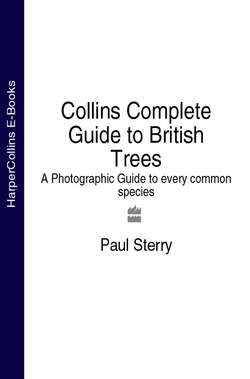Читать книгу Collins Complete Guide to British Trees: A Photographic Guide to every common species - Paul Sterry - Страница 36
ОглавлениеCOMPARING THE BARK OF COMMON TREES AND SHRUBS
At first glance, the bark of one tree can look pretty much like that of another. But, as with most things botanical, the more you look the more you will begin to discern similarities between the barks of trees of the same species, and differences between unrelated ones.
At this point it is worth raising a note of caution. The wise tree enthusiast will accept the fact that some individual trees cannot be identified by bark alone, for a number of reasons. Species such as Ash have bark that looks strikingly different depending on the growing conditions of the tree in question. Furthermore, in many species, the bark of young trees differs from older individuals, usually in being smoother and less rugged. It is also important to remember that the bark chemistry of certain tree species suits the needs of lichens and mosses, some of which are extremely colourful and can mask the true character of the bark. To check true bark colour, it is often necessary to scrutinise the shadiest side of a trunk.
With the above reservations, reasonably distinctive bark characteristics usually allow most common and widespread trees and certain larger shrubs to be identified with certainty. This ability is particularly valuable for people wishing to undertake conservation management of woodlands in winter and, with this in mind, the following images cover the commonest native and widely naturalised species to be found in Britain.
TREES
PEDUNCULATE OAK Quercus robur
Grey, with shallow ridges in young trees (A), becoming thick and deeply fissured with knobbly ridges in mature trees (B) and gnarled and rugged in ancient trees (C). The white spots in (B) are lichens; the green and blue patches in (C) are lichens and algae.
A
B
C
SESSILE OAK Quercus petraea
Greyish brown with shallow reddish fissures when young (A). Most trees acquire deep vertical fissures and knobbly ridges with age, the bark coloured by algae, as here (B), but some have rather shallow scales.
A
B
ASH Fraxinus excelsior
In young trees (A) smooth and pale grey (seen here with whitish lichens and yellowish algae), but in older trees (B) it becomes vertically fissured, although remaining grey-brown; the true colour is often obscured by the large colonies of lichens and mosses that grow well on mature Ashes in unpolluted areas (C).
A
B
C
SILVER BIRCH Betula pendula
Orange-red in young trees (A). In old trees, thick bark becomes deeply fissured at the base of the bole, often developing a pattern of dark diamond shapes (B); higher up the bole the bark is a smooth silvery white (C), often flaking away and revealing greyer patches below.
A
B
C
DOWNY BIRCH Betula pubescens
Purplish brown when young (A), becoming mostly smooth and brown or greyish with age and not breaking up into rectangular plates at the base like Silver Birch. The pale blue-grey patches in this picture (B) are lichens, the greenish epiphytes are mosses.
A
B
COMMON ALDER Alnus glutinosa
Brownish and fissured into square or oblong plates that are of reasonably even width; the pale blue-grey patches in this picture are lichens.
BEECH Fagus sylvatica
Smooth and grey in young trees (A), often with horizontal lines, but becoming rougher with shallow ridges in older specimens (B).
A
B
WYCH ELM Ulmus glabra
Smooth and greyish in younger trees (A), becoming browner with deep, mostly vertical cracks and ridges with age (B).
A
B
DUTCH ELM Ulmus × hollandica
Brown, cracking into small, shallow plates; the greenish coloration of the bark in this picture is caused by lichens.
BIRD CHERRY Prunus padus
Smooth dark and grey-brown, never peeling or fissuring. The greenish coloration in this picture is caused by algae and mosses. The bark releases a strong, unpleasant smell if rubbed.
WILD CHERRY Prunus avium
Reddish brown and shiny, with circular lines of lenticels; in older trees, peeling horizontally into tough papery strips, and occasionally becoming fissured. The greenish coloration seen here is caused by lichens.
WILD CRAB Malus sylvestris
Deep purplish brown, and cracking into small oblong plates; the green patches in this picture are mosses and algae.
SWEET CHESTNUT Castanea sativa
Silvery and smooth in young trees with fine vertical fissures (A); in older trees becoming more deeply fissured with grooves becoming markedly spiralled up the trunk (B).
A
B
HORSE-CHESTNUT Aesculus hippocastanum
Smooth and pinkish grey in young trees but soon greyish brown, often flaking away in large, rather rounded scales.
ASPEN Populus tremula
Smooth and greyish, with small, dark diamonds at first (A), becoming brown, ridged and fissured with age (B).
A
B
WHITE POPLAR Populus alba
Pale in young specimens and broken by diamond-shaped scars; in mature trees deeply fissured on lower part of trunk. The greenish coloration in this picture is caused by algae, lichens and mosses.
GREY POPLAR Populus × canescens
Similar to White Poplar. Whitish with diamond-shaped fissures in young trees (A), but darker grey-brown and deeply fissured at the base of older trees (B).
